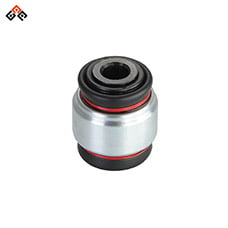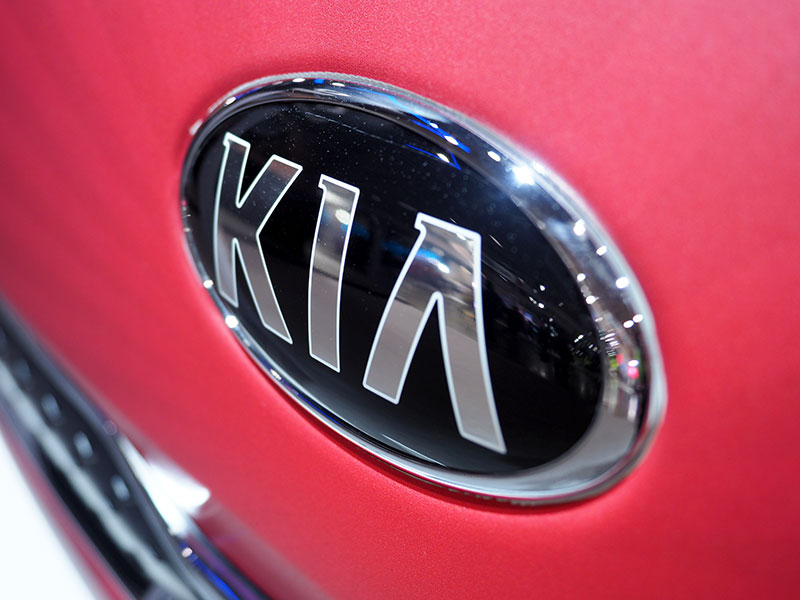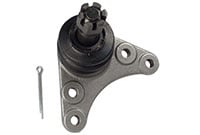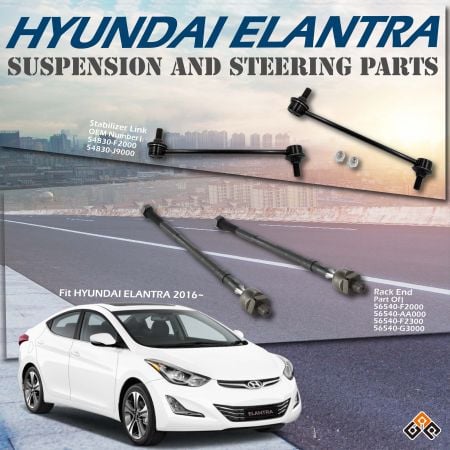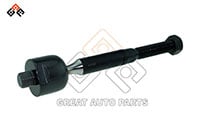Common Causes of Wear and Tear: Why KIA Stabilizer Bar Links Fail
Understand Why Your KIA Stabilizer Bar Link Does Not Last.
The stabilizer bar link plays a crucial role in your KIA's suspension system. It connects the stabilizer bar, or sway bar, to the vehicle's suspension, helping to reduce body roll during sharp turns or uneven road conditions. This component ensures a smoother ride and contributes to the stability and handling of the car. Over time, however, these links can wear out or fail, leading to potential safety issues and a decrease in driving comfort.
Common Reasons for Premature Wear of Stabilizer Bar Links
Stabilizer bar links are integral to your KIA’s suspension system, ensuring stability and reducing body roll. However, they can succumb to premature wear due to various factors:
Harsh Road Conditions
Driving frequently on rough, uneven roads exposes the stabilizer bar links to extreme stress. Each bump, pothole, or road imperfection translates to significant strain on these components, accelerating their wear and tear.
The continuous jarring impacts can lead to physical damage, including bending, breaking, or wearing out of the bushings, which compromises the link's effectiveness and the vehicle's stability.
Corrosive Elements
Exposure to corrosive substances like road salt, water, and chemicals, particularly in colder climates where salt is used to melt snow, can lead to rust and corrosion on the stabilizer bar links.Corrosion weakens the metal, making the links brittle and more susceptible to snapping or failing, especially under the strain of normal driving conditions.
Material Fatigue and Wear
Over time, the stabilizer bar links experience material fatigue due to the constant load and unloading forces they endure during regular vehicle operation. This stress can cause the links to weaken, especially at their joints and bushings.Fatigue leads to cracks, loosening, or complete failure of the links, resulting in compromised vehicle handling, increased body roll, and potentially affecting the safety of the vehicle.
Improper Installation
Incorrectly installed stabilizer bar links can lead to premature wear. This might occur if the links are not tightened to the manufacturer’s specified torque, leading to excessive movement or stress.
Lack of Regular Maintenance
Neglecting regular inspection and maintenance of the suspension system can allow minor issues with stabilizer bar links to escalate into major problems.
Without timely intervention, worn or damaged links can go unnoticed until they fail completely, potentially resulting in unexpected handling issues or even an increased risk of accidents.
Symptoms of Failing Stabilizer Bar Links
Unusual Noises
One of the most noticeable symptoms of a failing stabilizer bar link is the presence of unusual noises from the vehicle's suspension. These sounds typically manifest as clunking, rattling, or knocking noises, especially when driving over bumps or during sharp turns.
These noises occur because the stabilizer link is unable to effectively dampen the movement between the suspension and the body of the car, allowing excessive play that leads to these audible indications of instability.
Loose or Imprecise Steering
Worn or damaged stabilizer bar links can lead to a noticeable decrease in steering responsiveness. The steering might feel loose, or there may be a delay in the vehicle's response to steering wheel movements.
This occurs as the stabilizer bar fails to properly transfer the force between the left and right sides of the vehicle during turns, affecting the car’s handling and potentially compromising the driver's control over the vehicle.
Increased Body Roll
The stabilizer bar's primary function is to reduce the car's body roll during turns. If the links are failing, they can't hold the bar firmly, which results in increased body roll.
This heightened body roll can dramatically affect the vehicle’s stability, making it feel more top-heavy during turns and increasing the risk of rollover in extreme conditions.
Uneven Tire Wear
Faulty stabilizer bar links can lead to uneven distribution of weight and uneven tire wear. This is because the compromised links can cause the car to lean more on one side, putting uneven pressure on the tires.Uneven tire wear not only necessitates premature tire replacement but can also lead to poor handling and decreased grip, escalating the risk of accidents, especially in wet or slippery conditions.
Visual Inspection
Sometimes, the physical inspection of the stabilizer bar links can reveal signs of wear or damage. This might include visible signs of rust, corrosion, or physical damage to the links themselves or the bushings.Visual indicators provide a clear signal that the stabilizer links are compromised and require attention, ensuring that these issues are addressed before they lead to more significant handling or safety concerns.
How to Avoid Stabilizer Bar Link Breakage
- Regular Inspections: Periodically check your stabilizer links for signs of wear, damage, or corrosion. Early detection of issues can prevent complete breakage.
- Timely Replacements: Replace the stabilizer links at the first sign of damage or wear, even if they haven't completely failed yet, to avoid unexpected breakage.
- Avoid Harsh Driving Conditions: Whenever possible, steer clear of rough roads, deep potholes, or extreme off-roading conditions that can stress the stabilizer links.
- Use High-Quality Parts: Always opt for high-quality, durable stabilizer links, preferably those that meet or exceed OEM specifications, to ensure longer-lasting performance.
- Proper Installation: Ensure that stabilizer links are installed correctly and torqued to the manufacturer's specifications to prevent premature wear or failure.
- Regular Vehicle Maintenance: Maintain your vehicle’s overall health, including alignment checks and suspension inspections, to reduce undue stress on the stabilizer links.
Great Auto Parts Stabilizer Bar Link Features
- High-Strength Steel Construction: Crafted from durable cold or hot forged steel for long-lasting reliability and toughness.
- Advanced Anti-Rust Protection: Features a specialized surface treatment that shields against corrosion, extending the part's lifespan.
- Flexible 60-Degree Swing: Designed to support a minimum 60-degree swing angle, ensuring smooth and adaptive vehicle handling.
- Superior Pull-Out Strength: Matches or exceeds OE standards in pull-out strength, offering dependable performance and durability.
- Direct OE Replacement: Engineered for a perfect fit as a direct replacement, ensuring easy installation without any modifications.
- Low Minimum Order Quantity: Available with a minimum order quantity of just 30 pieces, providing flexibility and convenience for all order sizes.
| MODEL | YEAR | REMARK | POSITION | OE NO. | OTHER NO. | GAP NO. |
| BORREGO | 09~10 | REAR, R/L | 55530-2B000 55530-2B200 | K750279 JTS562 | SLHY-50279 | |
| SORENTO | 11~13 | |||||
| NIRO | 17~19 | FRONT, R/L | 55530-2S200 55530-2S100 101-7112 3913901 | K750594 JTS1594 | SLHY-50524 | |
| SPORTAGE | 11~13 | AWD | ||||
| SORENTO | 14~15 | AWD | REAR, LH | 55530-2W110 101-7931 | K750664 | SLHY-50664 |
| SORENTO | 14~15 | AWD | REAR, RH | 55540-2W110 55540-2W100 101-7932 | K750665 | SLHY-50665 |
| SORENTO | 11~13 | FRONT, LH | 54830-2B000 54830-2B200 101-5353 3397201 | K750204 JTS561 | SLHY-750204 | |
| SORENTO | 11~13 | FRONT, RH | 54840-2B000 54840-2B200 101-5354 3397301 | K750205 JTS560 | SLHY-750205 | |
| SPORTAGE | 05~10 | FRONT, R/L | 54830-2E000 54830-2E100 54830-1F000 | K80510 | SLHY-80510 | |
| SPORTAGE | 05~10 | REAR, R/L | 55530-2E100 55530-2E000 | K80511 | SLHY-80511 | |
| MORNING | 11~ | PICANTO | FRONT, RH | 54840-1J000 3584501 | JTS970 | SLHY-85000 |
| VENGA | 10~ | |||||
| VENGA | 10~ | PICANTO | FRONT, LH | 54830-1J000 3584401 | JTS967 | SLHY-85001 |
| CADENZA | 14 | FRONT, R/L | 54830-3Q000 101-7171 | SLHY-87171 | ||
| OPTIMA | 12~15 | |||||
| SPORTAGE | 11~13 | |||||
| OPTIMA | 12~15 | FWD | REAR, R/L | 55540-2Z000 101-6961 | SLHY-87172 | |
| SPORTAGE | 11~13 | FWD | ||||
| SORENTO | 14~15 | FRONT, R/L | 54830-2W000 101-7905 | SLHY-87905 | ||
| OPTIMA | 16 | REAR, LH | 55530-C1100 101-7935 | SLHY-87935 | ||
| OPTIMA | 16 | REAR, RH | 55540-C1100 101-7936 | SLHY-87936 | ||
| MAGENTIS | 06~10 | REAR, R/L | 55530-1D000 3673601 | K750357 | SLKI-50357 | |
| CARENS | 06~ | III, MPV | ||||
| OPTIMA | 06~10 | |||||
| RONDO | 07~12 | |||||
| CARENS | 00~05 | I, II | REAR, R/L | 0K2M2-28-150 0K2A1-34-150A 0K2A0-34-150B 3336101 | K90363 JTS569 | SLKI-50363 |


